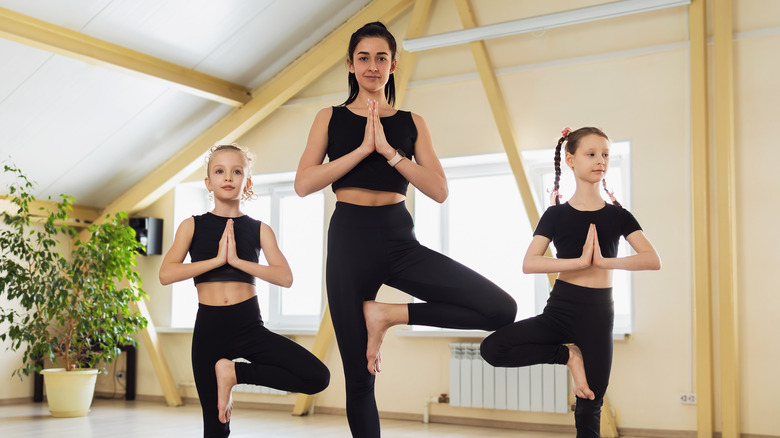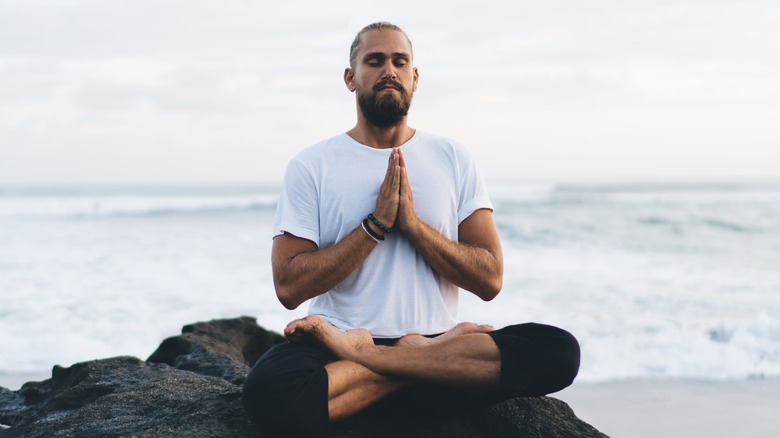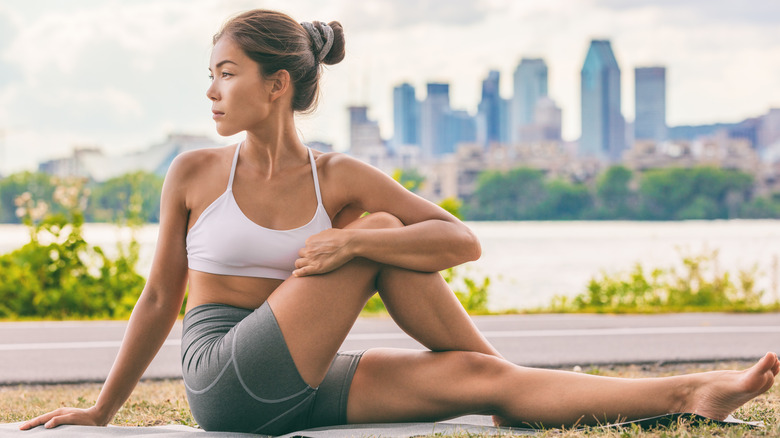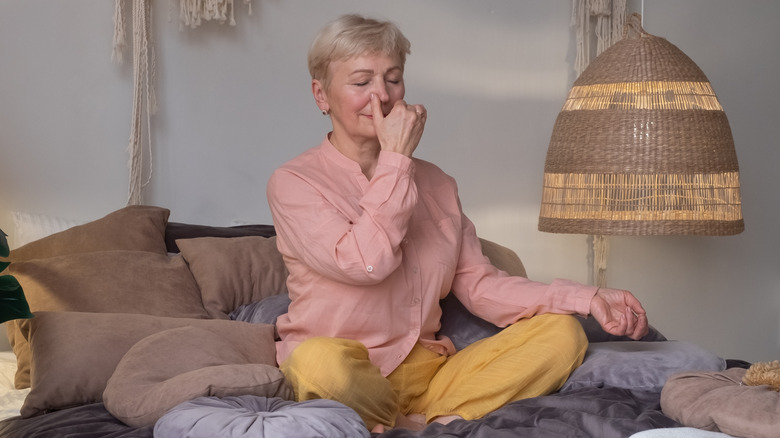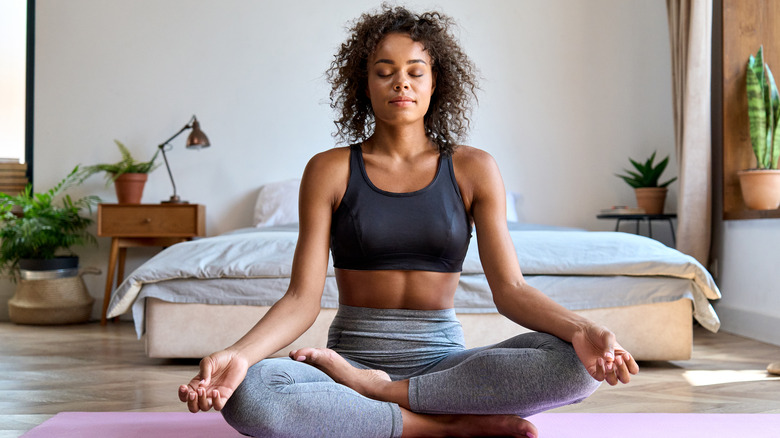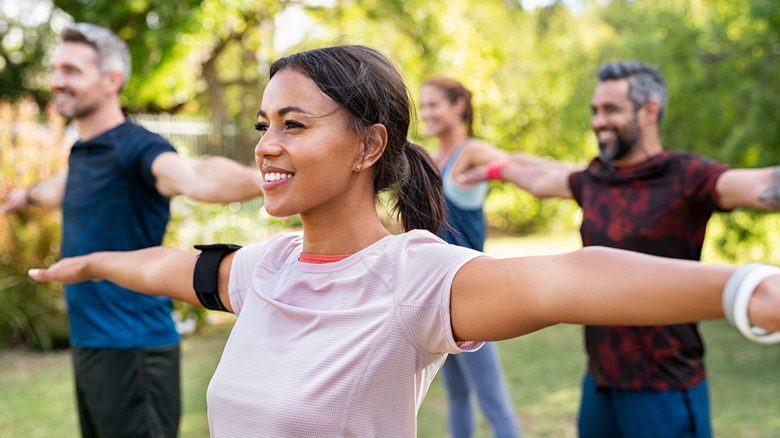Everything You Need To Know About Hatha Yoga
With a variety of yoga classes to choose from these days, you might come across a Hatha Yoga class. Even if you've never heard the word "hatha," you've probably seen people doing Hatha Yoga in various ads and websites. According to Yoga Journal, Hatha Yoga refers to physical yoga postures designed to prepare you for meditation. Therefore, most yoga classes technically fall under the larger umbrella of Hatha Yoga. This could include fiery practices such as Ashtanga or Bikram, or the gentler practices of yin or restorative yoga.
However, a Hatha Yoga offering tends to be somewhere in the middle, offering active postures focused on aligning the body while settling the mind. According to YogaJala, you do one pose at a time. You can use yoga blocks or bolsters to help anchor the body into each pose. Because the pace is much slower than in a vinyasa class, you have time to recover between each pose. Most Hatha Yoga classes are friendly for beginners (via Yoga Basics).
The history of Hatha Yoga
Although yoga has been practiced for centuries, Indian yogi Svatmarama wrote the Hatha Yoga Pradipika in the 15th century based on ancient texts and rituals passed down through the years (via Swami Jnaneshvara). The book consists of ascetic cleansing practices such as passing cords through the nasal passages and inserting a catheter into the anus. Is there any surprise that the word "hatha" is the Sanskrit word for forcefulness, per Yoga Basics?
Don't fear, because many of these rigorous practices have softened. Some of the Hatha Yoga practices remain, such as the various poses, the breath practices, and mudras, which are hand gestures to direct our energy (via Chopra). These practices still serve the same purpose, which is to clear out any mental or physical barriers to meditation.
To emphasize balancing the energy of the body, Hatha Yoga is often translated as the "union of sun and moon" rather than "willful" or "forceful", according to Yoga Basics.
Common poses in Hatha Yoga
Out of the 15 poses specified in Hatha Yoga Pradipika, 11 of them are seated poses (via Fitsri). However, you might not find all of them in a beginner's Hatha Yoga class because they require a lot of flexibility. You may instead see variations of these poses to make them accessible to all levels.
One of the most common poses you'll find in any yoga class, including Hatha, is paschimottananasana, or a seated forward bend. Although this might feel great after a long day, it can strain your back if you're not careful. To prevent this, sit on a folded blanket and keep a slight bend in your knees (per Yoga Journal). Hatha Yoga Pradipika also describes ardha matsyendrasana, which is a seated twist. The twist can wring out the tension in your back (via Ekhart Yoga).
Although standing poses weren't included in the Hatha Yoga Pradipika, you'll find plenty of them in a Hatha Yoga class. Standing poses, such as Warrior, Triangle, or Mountain, build strength and improve balance in the body (per MindBodyGreen). Hatha Yoga classes end with savasana, which is also known as corpse pose. This resting pose can be a challenge for people who have difficulty lying still (per Yoga Journal).
Hatha Yoga's breath practices
Breathwork, called pranayama, is becoming more popular for its health benefits. In a Hatha Yoga class, an instructor might teach box breath or other deep breathing methods. Although the Hatha Yoga Pradipika identifies many commonly-practiced breath techniques, Svatmarama categorizes them as purification practices. The main breath practice he describes is nadi shodhana, or alternate nostril breathing. Let's try it, following Svatmarama's instructions (per Swami Jnaneshvara).
Find a comfortable seat, and close your right nostril with your right thumb. Fill your lungs by breathing through the left nostril, pause for a moment, then close off your left nostril with your right ring finger and breathe out slowly through your right nostril. For the next breath, inhale through your right nostril, pause, and breathe out through your left. If this pattern gets confusing, always remember to breathe out through the opposite nostril through which you inhaled. Be sure to keep your breath slow, and don't force it.
Svatmarama wrote that this breath practice balances and purifies the body, according to Swami Jnaneshvara.
Meditation might be easier after a yoga class
Some yoga instructors will save a few minutes at the end of class for meditation. Because meditation can benefit your health, it can seal your yoga practice and leave you in a different state of mind than before you walked into class. Since Hatha Yoga helps to balance the body and mind, you might find meditation to be a little easier after moving your body through the yoga poses (via Healthline).
However, meditation doesn't necessarily mean sitting in a specific pose and chanting a mantra. You can practice meditation during your Hatha Yoga class while you're holding poses. Because you're concentrating on what your body is doing in the pose, you're already steadying the mind. Your mind might also focus while you're practicing alternate nostril breathing. A major component of mindfulness meditation is getting your mind off autopilot, according to Mindful. Try awareness and breathing exercises (via Mayo Clinic).
Health benefits
Many people might choose yoga for improved mental health. A 2018 study in Behavioral Medicine found that after 10 weeks, practicing Hatha Yoga reduced physiological markers among patients with current or recent depression. In fact, Hatha Yoga can lower stress levels with a single class. A 2013 study in the Journal of Nursing Research compared perceived stress levels between a control group and a group that took a 90-minute Hatha Yoga class. The yoga group reported significantly lower stress levels after just one class. After eight weeks, the yoga group's physiological stress indicators had decreased.
A 2016 systematic review in The Journal of Alternative and Complementary Medicine looked at the effects of Hatha Yoga on our cognitive skills. The review concluded that Hatha Yoga shows promise when it comes to improving the mental skills of children, healthy adults, certain medical populations, and impulsive prisoners.
Even though vinyasa yoga is typically more physically demanding, Hatha Yoga also has physical benefits. According to a 2010 review in The Health & Fitness Journal, Hatha Yoga can improve balance, flexibility, and strength. When combined with meditation and breathing exercises, it may even be beneficial to heart health and help alleviate symptoms of arthritis, insomnia, and other health conditions.
With that said, the National Institutes of Health suggests consulting a doctor and yoga instructor before starting a yoga practice if you are pregnant, over the age of 65, or have health conditions. You may need to avoid or modify certain practices.

